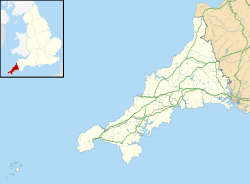St Nonna's Church, Altarnun facts for kids
Quick facts for kids St Nonna's Church, Altarnun |
|
|---|---|
 |
|
| 50°36′17″N 4°30′46″W / 50.604608°N 4.512809°W | |
| Denomination | Church of England |
| Previous denomination | Roman Catholic |
| Website | St Nonna, Altarnon |
| History | |
| Dedication | Saint Nonna |
| Administration | |
| Parish | Altarnun |
| Deanery | Trigg Major |
| Archdeaconry | Bodmin |
| Diocese | Truro |
| Province | Canterbury |
St Nonna's Church is a very old and important church. People sometimes call it the Cathedral of the Moors. It's the second biggest church on Bodmin Moor in Cornwall. You can find it in the village of Altarnun, which means 'altar of Nonn'.
The church is named after Saint Non (or Nonna). She was the mother of St David, a very famous saint. The church is even mentioned in a famous book called Jamaica Inn by Daphne du Maurier. In the story, the church is where a character, the vicar Francis Davey, paints a strange picture.
Today, St Nonna's Church is an active Anglican parish church. It belongs to the Church of England. It is part of the diocese of Truro. The church is also a special "Grade I" listed building. This means it's a very important historic building in England.
Contents
History of St Nonna's Church
The oldest parts of the church were built a very long time ago. These parts date back to the Norman era. Most of the church you see today was built later. This happened in the late 1400s. During that time, the north and south aisles were added.
The church was later repaired and updated in 1867. This type of repair is called a Victorian restoration. It was done by E. Sedding.
Architecture and Design
St Nonna's Church was mostly built in the 1400s. It shows the "Perpendicular style" of architecture. This style is known for its tall, straight lines. The church has a tall tower that is about 109 feet (33 meters) high.
Special Features Inside
The church has many interesting old wooden parts. These include a beautiful screen, special bench-ends, and communion rails. The communion rails were made in 1684.
The screen is one of the best examples from the 1400s in Cornwall. It has three gates. The carvings of vines and other designs are very detailed.
There are 79 unique carvings on the bench-ends. A craftsman named Robert Daye made these between 1510 and 1530. One carving even shows a Cornish piper and a fiddler. Robert Daye's name is on one of them. A local expert, Douglas Edwards, repaired one of the damaged pew ends in the 1980s.
The church also has eight bells that can be rung together.
Gallery of Images
Outside the Church
Around the church, there are five other important structures. These are also "Grade II" listed. This means they are historically important.
These include the entrances to the churchyard. There are gates, gateposts, and a wall. There is also a special stone block for getting onto horses. Two old tombs are also in the churchyard. These are the Isbell tomb and another tombchest with a headstone.







